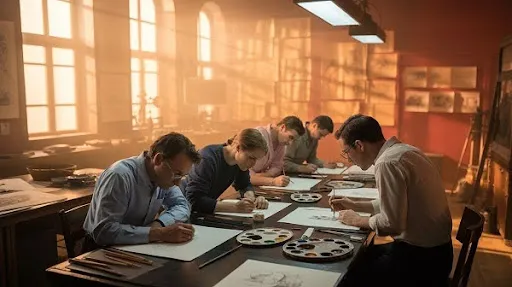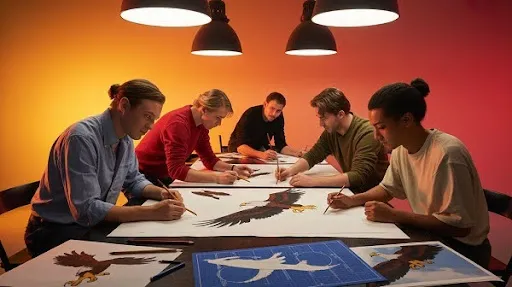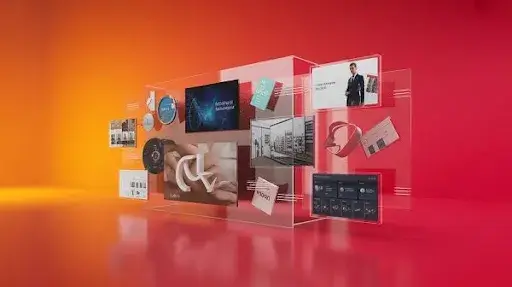Animation today covers everything from slick CGI to stylized 3D characters and motion graphics that feel almost real. But if you strip all of that away, the roots are surprisingly simple pencil drawings, pots of paint, and stacks of transparent sheets. That’s cel animation, the technique that laid the groundwork for the industry.
It was never just a technical shortcut. Cel animation shaped the way audiences connected with moving pictures. Think of Mickey Mouse bouncing across the screen, Looney Tunes chaos, or Studio Ghibli’s emotional storytelling all of it came from this frame-by-frame craft.
At Prolific Studio, we don’t treat it as a relic. It’s a foundation. Even when we use digital software, the principles behind cel animation guide the way we tell stories.
What is Cel Animation?
At its core, cel animation is hand-drawn frame-by-frame animation. Each drawing is placed on a sheet of clear celluloid a “cel.” This lets artists separate moving characters from the background. Instead of redrawing an entire forest every time a character blinked, they could just animate the blink on a new cel and place it over the background painting.
That breakthrough changed the game. Layer the cels, shoot them with a camera, and the illusion of motion appears. Those original sheets, often called animation cels, are still around today. Collectors prize them because each one is a frozen moment the artist’s hand visible in every brush stroke.
The History of Cel Animation
The early years
Before cels, making a cartoon meant redrawing everything from scratch. It was painfully slow. In 1914, Earl Hurd patented the idea of using transparent sheets so only the moving parts had to be redone. That single tweak transformed animation into something practical for studios.
Disney changes the stakes
Not long after, Walt Disney leaned into the method. His team refined it, and by 1937, they released Snow White and the Seven Dwarfs. A full-length film made with cels something no one thought was possible before. That film proved animation wasn’t just “kids’ shorts” anymore; it could carry drama and emotion like live-action cinema.
Other players
Disney wasn’t alone. Fleischer Studios gave us Betty Boop and Popeye. Warner Bros. built Bugs Bunny, Daffy, and the whole Looney Tunes crew. Decades later, Studio Ghibli layered dreamy backgrounds and nuanced characters over the same cel process. These examples of cel animation continue to influence how animators frame stories today.
Fact: Prices for limited-edition or reproduction cels can differ significantly. For example, exclusive Disney sericels (prints) could cost approximately $2,300 when framed, whereas more typical Hanna-Barbera versions may sell for less than $350.
What Makes Cel Animation Different
Cel animation has a look and feel you can’t quite fake:
- The handmade quality. You see pencil lines, brush strokes, even little quirks where the paint isn’t perfect.
- Depth. Stacking cels over a background gave the illusion of space long before 3D software came around.
- Movement with personality. Frame-by-frame drawings carry rhythm and life that feels human.
- Something you can hold. Each cel is a physical artifact part artwork, part production tool.
At Prolific Studio, we point these out often. They’re not accidents. They came from patience, practice, and a lot of hours hunched over a desk.
How Animators Made It Work
Making a cel-animated film wasn’t quick, but the steps were clear enough:
- Storyboarding. Sketches laid out like a comic strip mapped how the story would play out.
- Key drawings and inbetweens. Senior animators drew the main poses; assistants filled the gaps to smooth out the movement.
- Inking and painting. The drawings were traced onto cels, ink on one side and paint on the other, so the colors stayed clean.
- Background art. Entire teams painted landscapes and interiors, usually in watercolor or gouache.
- Frame photography. Finished cels were stacked on the backgrounds and shot under a special camera, one frame at a time.
It could take years to finish a feature. The pace was grueling, but the warmth and character of the result made it worth it.
Tools and Tricks That Defined Cel Animation
Beyond the drawings themselves, animators relied on a few key tools:
- Model sheets to keep characters consistent, no matter who drew them.
- Exposure (dope) sheets to line up timing, dialogue, and music.
- Layering cels so multiple things could move without redrawing entire scenes.
- Rotoscoping tracing live-action footage for lifelike motion.
- Painted lighting to suggest mood or depth without 3D rendering.
These tricks became the unofficial rulebook of traditional animation. Most animators still study them before moving on to digital tools.
Cel Animation vs Digital Animation
Comparing cel animation v digital animation isn’t about declaring a winner. They each shine in different ways:
- Cel: tactile, expressive, dripping with personality, but painfully slow.
- Digital: efficient, flexible, easy to revise, but often struggles to capture that handcrafted warmth.
At Prolific Studio, we mix both. Digital helps us move fast, but we still lean on the expressive timing and human touch of cel principles. That blend keeps projects polished yet alive.
The Shift Into Digital
As technology advanced, studios adapted. Instead of photographing cels, they scanned drawings into computers. Tools like Toon Boom and Adobe Animate recreated the cel workflow in digital form. The technique stayed the same, but the materials changed.
Disney’s short Paperman is a great hybrid example. Hand-drawn animation sat on top of 3D environments, showing how old methods can evolve instead of disappear.
Even now, animators work from the same basics: timing, spacing, and anticipation. The advancement of cel animation techniques and technology didn’t erase tradition it built on it.
Why Prolific Studio Still Uses It
People sometimes ask why we still bother using cel animation when software can handle so much. The answer: because it’s the foundation. If you know how to breathe life into a pencil drawing, you’ll have no trouble adapting to digital tools.
At Prolific Studio, we fold these lessons into client projects, workshops, and our own productions. The result is animation that moves smoothly, characters that feel alive, and visuals that connect. Old-school craft, modern tools the two go hand in hand.
Cel Animation in the Modern World
When people think of cel animation, they often picture golden-era cartoons or Disney classics. But cel animation isn’t locked in the past. Its principles timing, spacing, anticipation, and expressive design still find their way into modern media. Even when the tools are digital, the sensibility remains rooted in hand-drawn craft.
Where Cel Animation Still Shows Up
Film and TV
Plenty of studios still use cel-inspired methods in films, shorts, and series. Even if the work is finished digitally, animators apply the same hand-drawn approach to characters and movement. The popularity of anime proves there’s still global demand for frame-by-frame artistry.
Advertising
Brands that want to stand out often commission animation that looks hand-crafted. A cel-inspired style feels more personal, more “made by humans,” which can connect better with audiences than slick but generic motion graphics. At Prolific Studio, we’ve seen clients light up when we show them how hand-drawn elements can bring warmth into explainer videos or ads.
Gaming
Video games borrow heavily from cel animation. Think of titles that use 2D animation services or stylized character movement. The same principles from cel days squash and stretch, anticipation, exaggeration are what make digital characters feel responsive and fun.
Education and Training
Cel animation is also a teaching tool. Animation schools continue to start students with traditional methods before handing them digital software. Why? Because if you can animate with pencil and paper, you can adapt to any program. At Prolific Studio, our training emphasizes this same foundation.
Brand Identity
Many companies use cel-inspired work to create unique brand characters. A hand-drawn mascot animated with cel techniques feels more authentic than a generic 3D render. That “human touch” builds trust and memorability.
The Advantages of Cel Animation
Even with modern tools at our disposal, cel animation brings qualities that can’t be replaced:
- Authenticity. Every frame has an artist’s touch, visible in the lines and brushwork.
- Charm. Imperfections a slightly wobbly line, a unique brush stroke add personality.
- Tactile artistry. The artwork exists physically, as cels and painted backgrounds, not just as files.
- Strong foundations. Cel training teaches animators to understand movement deeply, which translates to better results in any medium.
At Prolific Studio, these advantages are why we continue to use cel animation as a teaching and creative tool. Clients who want work that “feels alive” often lean toward this style.
The Challenges of Cel Animation
Of course, cel animation isn’t without drawbacks:
- Time-consuming. Drawing and painting every frame is a long process.
- Cost. More hours mean higher budgets compared to quick digital alternatives.
- Materials. Traditional supplies cels, inks, paints are harder to source today.
- Storage. Physical artwork takes space and requires careful preservation.
That’s why most studios, including ours, adapt the cel workflow digitally. You get the expressive timing and hand-drawn feel, but with the speed and flexibility of modern software.
Cultural and Artistic Impact of Cel Animation
Cel animation isn’t just a technique it’s a cultural force. Whole generations grew up on Disney classics, Warner Bros. shorts, and anime. These works shaped how people view storytelling, humor, and visual art.
- Global influence. Anime’s rise spread cel techniques worldwide, inspiring countless artists.
- Art collecting. Original cels are now prized as collectible art pieces, bridging pop culture and fine art.
- Aesthetic inspiration. Even digital designers borrow the cel look, mimicking brush strokes, flat color fills, and line work in software.
At Prolific Studio, we see this influence daily. Clients often ask for work that “feels like old-school animation,” even if they don’t know the term cel animation. It’s proof of how deep its cultural footprint runs.
The Future of Cel Animation
Will cel animation survive in the digital age? Absolutely though it will evolve. Hybrid approaches are already the norm. For example:
- Digital cel pipelines replicate the old process while eliminating the need for physical sheets.
- Mixed-media projects combine hand-drawn characters with 3D environments.
- Experimental animation uses cel-inspired work for music videos, VR experiences, and interactive media.
At Prolific Studio, we’re constantly exploring these hybrids. The goal isn’t to abandon tradition but to carry its spirit into whatever comes next.
Frequently Asked Questions
Is cel animation still used today?
Yes, though mostly in digital form. The process of frame-by-frame drawing remains, but instead of physical cels, artists use programs like Toon Boom or TVPaint.
Why is cel animation important in animation history?
It revolutionized the industry by making animation practical for long projects. It also shaped the “language” of movement that modern animators still study.
What’s the difference between cel animation and digital animation?
Cel is physical and hand-drawn, while digital uses software. Cel is slower but has more tactile charm. Digital is faster and easier to revise. Many modern studios blend both.
Can I still buy original animation cels?
Yes, collectors and galleries often sell them. Disney, Warner Bros., and anime studios have all released original production cels that are now valuable art pieces.
Why does Prolific Studio value cel animation?
Because it’s the backbone of good animation. Our team believes that if you understand cel techniques, you can adapt to any new tool or style with ease.
Conclusion
Cel animation may have started more than a century ago, but its influence hasn’t faded. From Disney to Ghibli, from Saturday morning cartoons to modern anime, the style left a permanent mark on how we see stories move. Even in today’s digital world, its charm, warmth, and authenticity continue to inspire both audiences and creators.
At Prolific Studio, one of the top animation studios in Reno, we view cel animation not as an outdated practice, but as a living foundation. Whether we’re training new animators, designing characters for brands, or producing full-scale animated campaigns, the lessons of cel animation guide our work. Old-school craft combined with modern tools that’s what keeps animation alive and human.
If you’re looking for animation that balances efficiency with artistry, let’s talk. Prolific Studio can bring your ideas to life with the same expressive touch that made cel animation unforgettable.
Related articles:










